If you want to know about the objective of design or LE Corbusier or auditorium design, please click the link.
Villa Savoye is a modernist villa designed by the Swiss-French architect Le Corbusier. It is located in the town of Poissy, outside Paris, France, and was built between 1928 and 1931.
1) Le Corbusier’s villa Savoye
The villa is a prime example of Le Corbusier’s “Five Points of Architecture,” which were his design principles for modernist architecture. The Five Points are:
- Pilotis: The use of slender columns to raise the building off the ground, allowing for an open floor plan and the free circulation of air and light beneath the structure.
- Free plan: The ability to create an open interior space by eliminating load-bearing walls and using a flexible, modular design.
- Free facade: The ability to create a facade that is independent of the structure, allowing for large windows and openings that provide ample natural light and ventilation.
- Ribbon windows: A continuous band of windows that wrap around the corners of the building, providing panoramic views and maximizing the amount of natural light that enters the space.
- Roof terrace: A flat roof that can be used as a living space and garden, adding an additional level of outdoor living to the home.
The Villa Savoye features all of these elements, with a sleek, white facade and a dramatic, sculptural staircase leading to the roof terrace. The interior is spacious and open, with large windows and a minimalist aesthetic that reflects Le Corbusier’s vision of modern living.
2) Villa Savoye – exterior
The exterior of Villa Savoye is a striking example of modernist architecture. It is a white, rectangular box with a flat roof, and features the distinctive elements of Le Corbusier’s Five Points of Architecture.
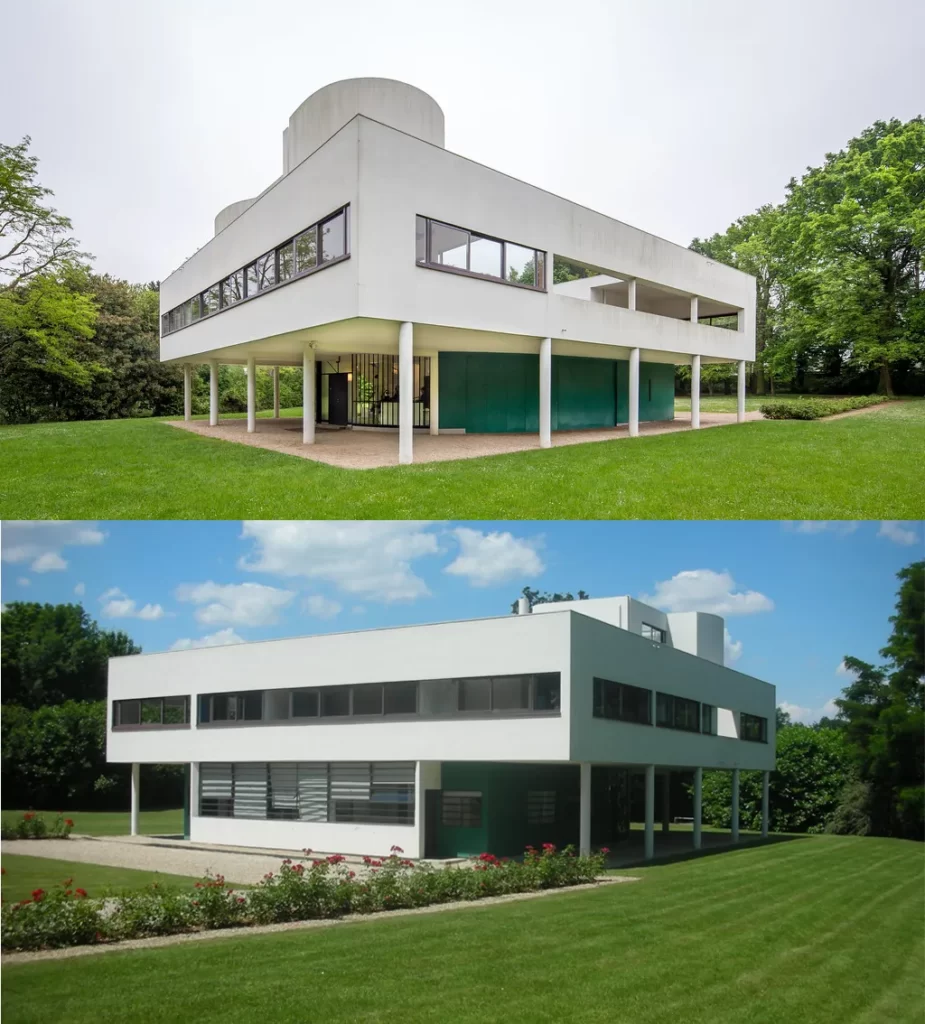
- One of the most striking features of the exterior is the use of pilotis, which are slender, cylindrical columns that elevate the building off the ground.
- The pilotis support the weight of the structure, allowing for an open floor plan and creating a sense of lightness and transparency.
- The villa’s facade is also notable for its use of ribbon windows, which wrap around the corners of the building and provide panoramic views of the surrounding landscape.
- The windows are long, horizontal strips that create a sense of continuity and flow, and they allow for ample natural light and ventilation.
3) Villa savoye – ground floor, entrance
The ground floor of Villa Savoye is designed to be a functional living space that is open and flexible, with an emphasis on natural light and ventilation. The entrance to the villa is located on the west side of the building, facing the street.

- The entrance is accessed by a ramp that leads up to the main door, which is located in a recessed area of the facade.
- The door is made of metal and glass, and features a grid of squares that allow natural light to filter into the interior.
- Upon entering the villa, visitors are greeted by a large, open space that serves as a vestibule and provides access to the main living areas.
- The vestibule features a curving wall that leads to the stairway and the upper floors.
4) Villa savoye – garage sliding door
The garage of Villa Savoye is located on the ground floor and is designed to accommodate two cars. The garage is accessed by a ramp that leads down from the street level, and features a large pivoting door that can be slid open or closed for easy access.
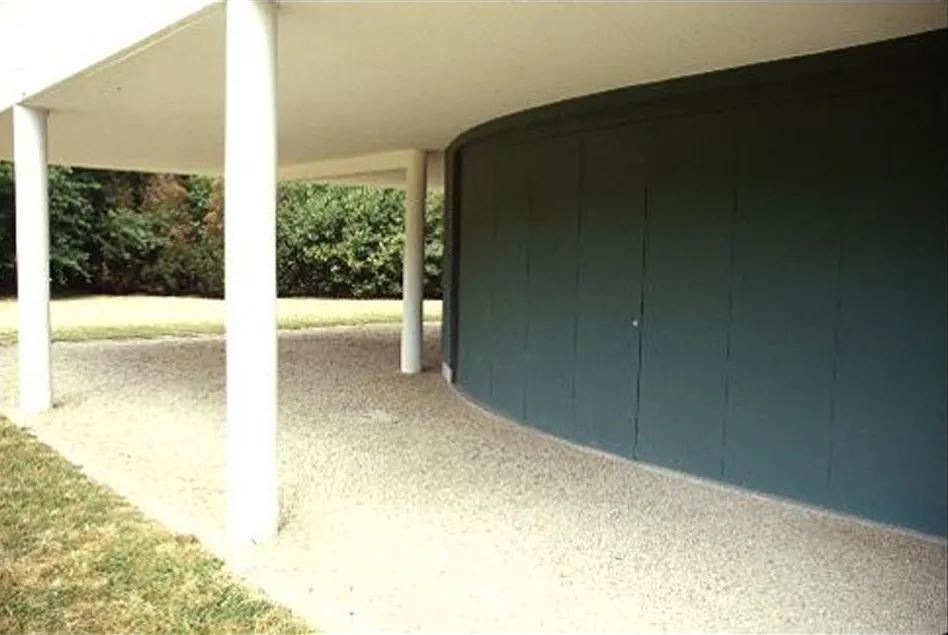
- The garage sliding door is a notable feature of the villa, as it was designed to be functional and aesthetic. It is made of steel and glass, with a grid of squares that matches the design of the main entrance door.
- The door is mounted on rollers that allow it to slide open and closed along a track, creating a smooth and easy movement. When the door is closed, it provides a clean and seamless facade, with the grid of squares creating a geometric pattern that blends into the overall design of the building.
- The garage sliding door is also designed to allow for natural light and ventilation. When the door is open, it creates an open-air space that is connected to the surrounding environment, allowing for air to circulate and for natural light to filter into the garage.
5) Spiral staircase
The spiral staircase is one of the most iconic features of Villa Savoye, and it is located at the center of the building. The staircase serves as the main circulation element between the different floors of the villa, and it is a striking example of Le Corbusier’s modernist design principles.

- The spiral staircase is made of reinforced concrete and is shaped like a helix, with a gently curving form that allows for a smooth ascent and descent between the floors.
- The staircase is supported by a central cylindrical column, which acts as the structural core of the building.
- The stairs are relatively narrow, and they are surrounded by a curved balustrade made of metal.
- The balustrade is designed to create a sense of lightness and transparency, allowing natural light to filter through and creating a visual connection between the different floors.
6) Roof garden
The roof garden, also known as the roof terrace, is a distinctive feature of Villa Savoye’s design. Located on the top of the building, the roof garden is accessible by a sculptural, curved staircase and provides a unique outdoor space that offers breathtaking views of the surrounding landscape.
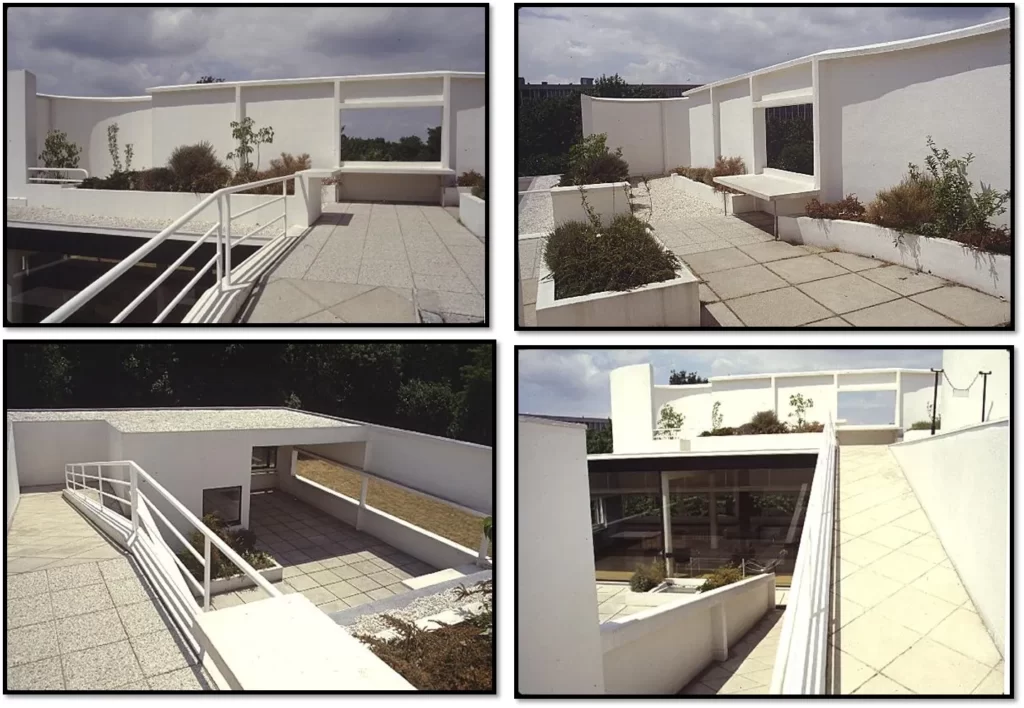
- The roof garden is a flat, open space that is designed to serve as an additional living area, and it features several design elements that reflect Le Corbusier’s modernist design principles.
- The terrace is surrounded by a low, curved wall that provides a sense of enclosure and privacy, and it is supported by pilotis that elevate it above the surrounding environment.
- The roof garden is designed to allow for a variety of uses, such as outdoor dining, sunbathing, or relaxing. It features built-in seating areas, as well as a small pond that adds a natural element to the design.
- The terrace is also designed to maximize natural light and ventilation.
- It is surrounded by a ribbon window that provides panoramic views of the surrounding landscape, and it features an open-air design that allows for air to circulate and for natural light to filter through.
7) Interior view
The interior of Villa Savoye is characterized by an open and airy design that features large windows and an emphasis on functionality and simplicity. The villa’s interior spaces are organized around a central spiral staircase, which serves as the main circulation element between the different floors.

- The ground floor of the villa features a spacious entrance hall that leads to the living and dining areas. The living room is a large, open space that is characterized by a curved wall of windows that provides stunning views of the surrounding landscape. The dining room is located adjacent to the living room and features a large table that can accommodate up to ten guests.
- The first floor of the villa features the bedrooms and bathrooms. The bedrooms are simple and functional, with built-in closets and large windows that provide natural light and ventilation. The bathrooms are also designed with functionality in mind and feature modern fixtures and clean lines.
- The second floor of the villa is the roof garden, which is a unique and functional space that offers breathtaking views of the surrounding landscape. The roof garden is designed to serve as an outdoor living area, with built-in seating areas and a small pond that adds a natural element to the design.
Throughout the interior of Villa Savoye, Le Corbusier used a limited palette of materials and colors, which creates a sense of continuity and flow between the different spaces. The walls are painted white, while the floors are made of polished concrete, creating a clean and modern aesthetic.
8) Ground floor plan
The ground floor plan of Villa Savoye is an important example of Le Corbusier’s modernist design principles, with an open plan layout and a strong emphasis on functionality. The floor plan is organized around a central spiral staircase, which serves as the main circulation element between the different levels of the villa.
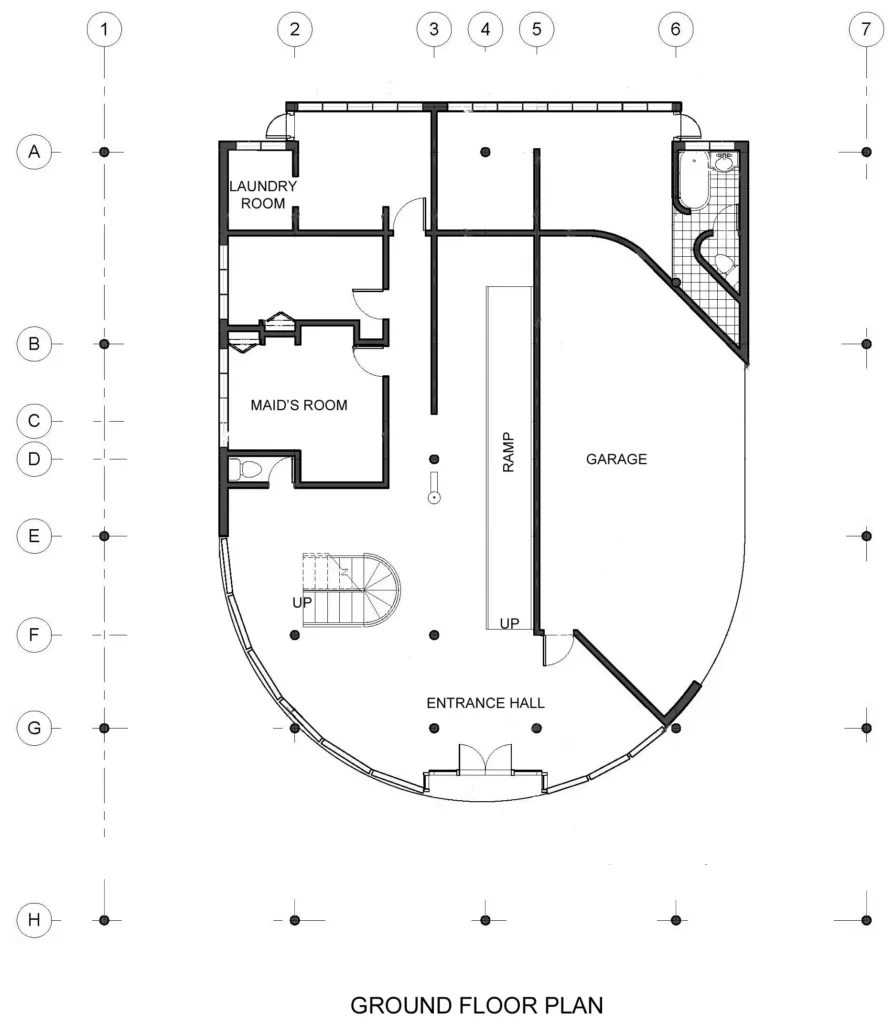
- Starting from the entrance, there is a spacious foyer that leads to the living room and dining room. The living room is a large, open space that features a curved wall of windows that provides stunning views of the surrounding landscape.
- Adjacent to the living room, there is a small room that can be used as a library or office. The dining room is located next to the living room and is connected to the kitchen.
- The kitchen is a functional space that features modern appliances and fixtures, and it is designed to be easily accessible from both the dining room and the outdoor terrace. The outdoor terrace is located on the other side of the dining room and features a covered area for outdoor dining and relaxation.
- The garage is located at the rear of the villa and is accessible through a sliding door. It is designed to accommodate a single car and features a ramp that leads to the lower level of the villa.
The ground floor plan of Villa Savoye is characterized by an open and airy design that allows for easy flow between the different spaces. The use of glass walls and large windows creates a sense of continuity with the surrounding environment, while also allowing for ample natural light and ventilation. Overall, the ground floor plan of Villa Savoye is a prime example of Le Corbusier’s modernist design principles and reflects his commitment to functionality, simplicity, and the integration of natural elements in architectural design.
9) First floor plan
The first floor plan of Villa Savoye is designed primarily for private spaces, including bedrooms and bathrooms. The floor plan is organized around the central spiral staircase, which serves as the main circulation element between the different levels of the villa.
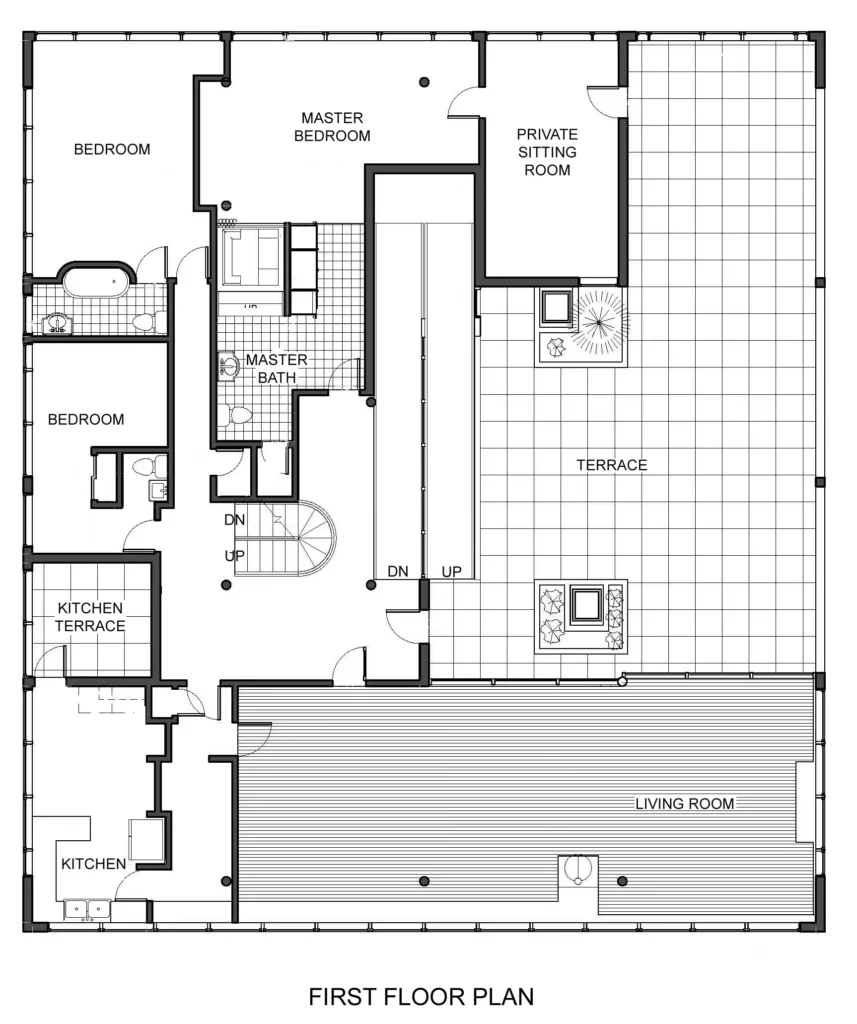
- The first floor includes four bedrooms, each with an attached bathroom. The bedrooms are located in the four corners of the building, and each room features a large window that provides natural light and ventilation. The bathrooms are designed with functionality in mind and feature modern fixtures and clean lines.
- In addition to the bedrooms and bathrooms, the first floor also includes a small circular room that can be used as a dressing room or as an additional bedroom. There is also a small balcony located on the western side of the villa, which provides a panoramic view of the surrounding landscape.
- The first floor of Villa Savoye is designed to be a private and comfortable living space, with a strong emphasis on functionality and simplicity.
- The open and airy design of the bedrooms and bathrooms allows for easy flow between the different spaces, while the use of large windows and natural materials creates a sense of continuity with the surrounding environment.
Overall, the first floor plan of Villa Savoye is a prime example of Le Corbusier’s modernist design principles, with an emphasis on functionality, simplicity, and the integration of natural light and ventilation. The design of the first floor reflects Le Corbusier’s commitment to creating comfortable and functional living spaces that are in harmony with the surrounding environment.
10) Roof plan
The roof plan of Villa Savoye is an important example of Le Corbusier’s innovative approach to architectural design. The roof of the villa serves as a functional outdoor space, with a roof garden that provides stunning views of the surrounding landscape.
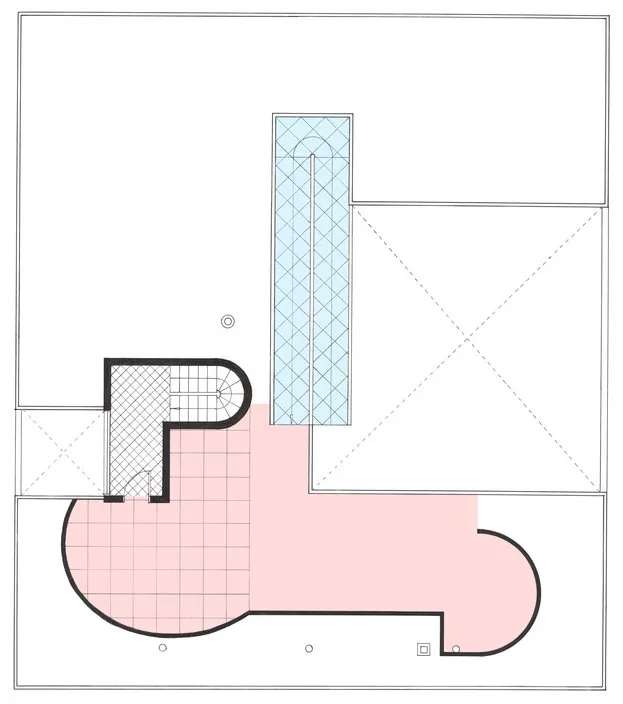
- The roof garden is designed as a large, open space that features several different functional areas. The largest area is a rectangular terrace that provides a panoramic view of the surrounding area. The terrace is paved with white stones and is surrounded by a low wall that provides a degree of privacy and safety.
- On the eastern side of the roof garden, there is a small pond that adds a natural element to the design. The pond is designed to catch rainwater and can be used as a cooling element during hot weather.
- The roof garden also includes a covered area that can be used for outdoor dining and relaxation. This area is located on the southern side of the terrace and is protected from the sun by a large concrete canopy.
Overall, the roof plan of Villa Savoye is a unique and functional design that reflects Le Corbusier’s commitment to creating living spaces that are in harmony with the natural environment. The roof garden serves as a functional outdoor space that is designed to take advantage of the surrounding landscape, while also providing a comfortable and functional living space for the residents of the villa.
11) Plan, section & view

12) Legends of villa savoye
In architectural drawings, a legend (also known as a key) is a list of symbols and their meanings. These symbols are used to represent different elements of the building design, such as walls, doors, windows, and other architectural features.

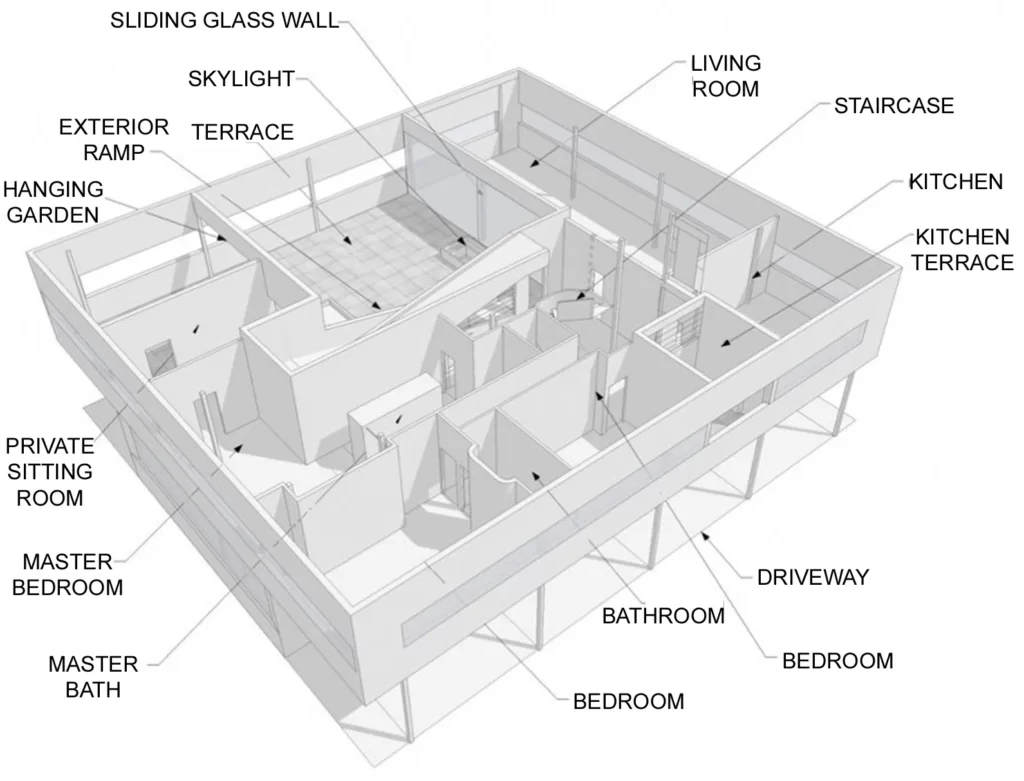
13) Section

14) Floor plans
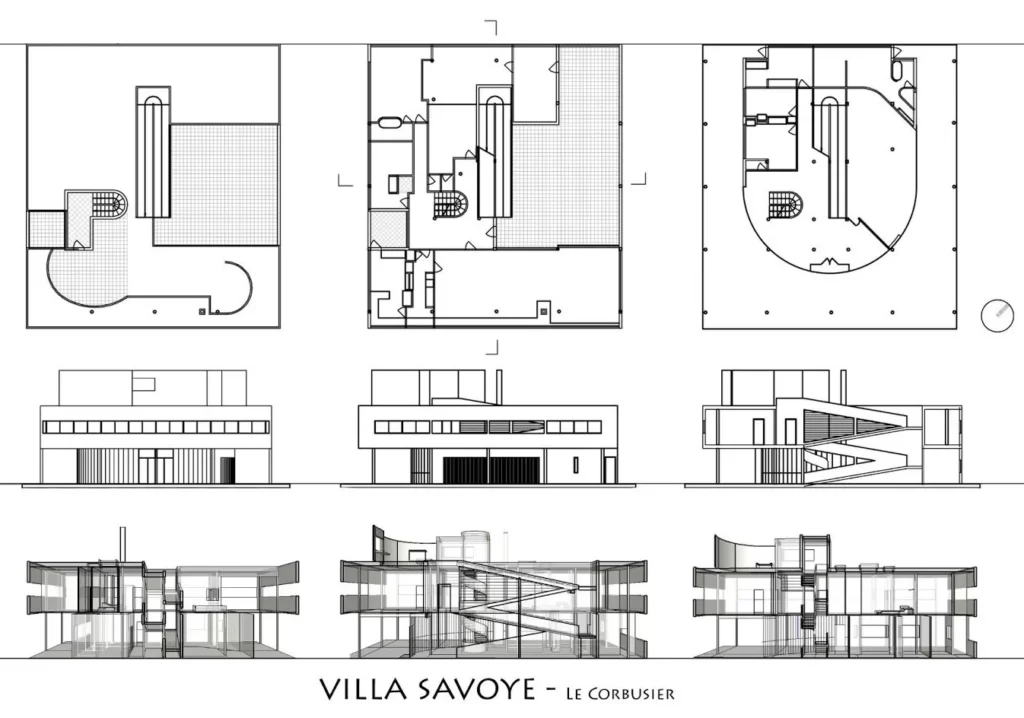
15) Views
There are several views that can be used to represent a building’s design, including elevation views, plan views, section views, and perspective views. In the case of Villa Savoye, these views help to showcase the building’s unique features and design elements, and provide insight into the architect’s vision.

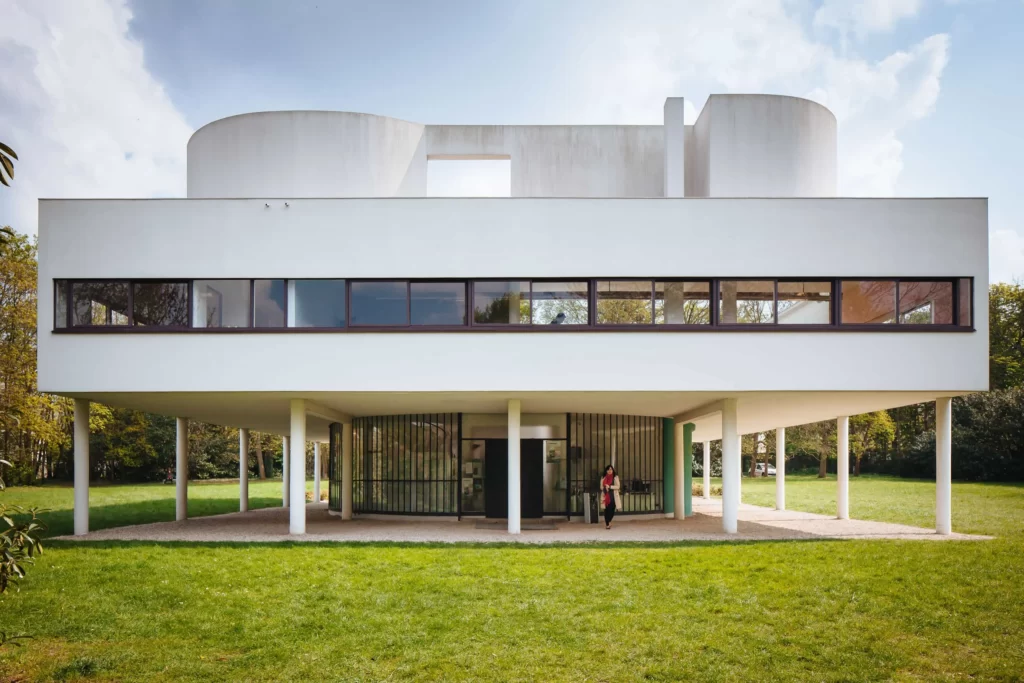
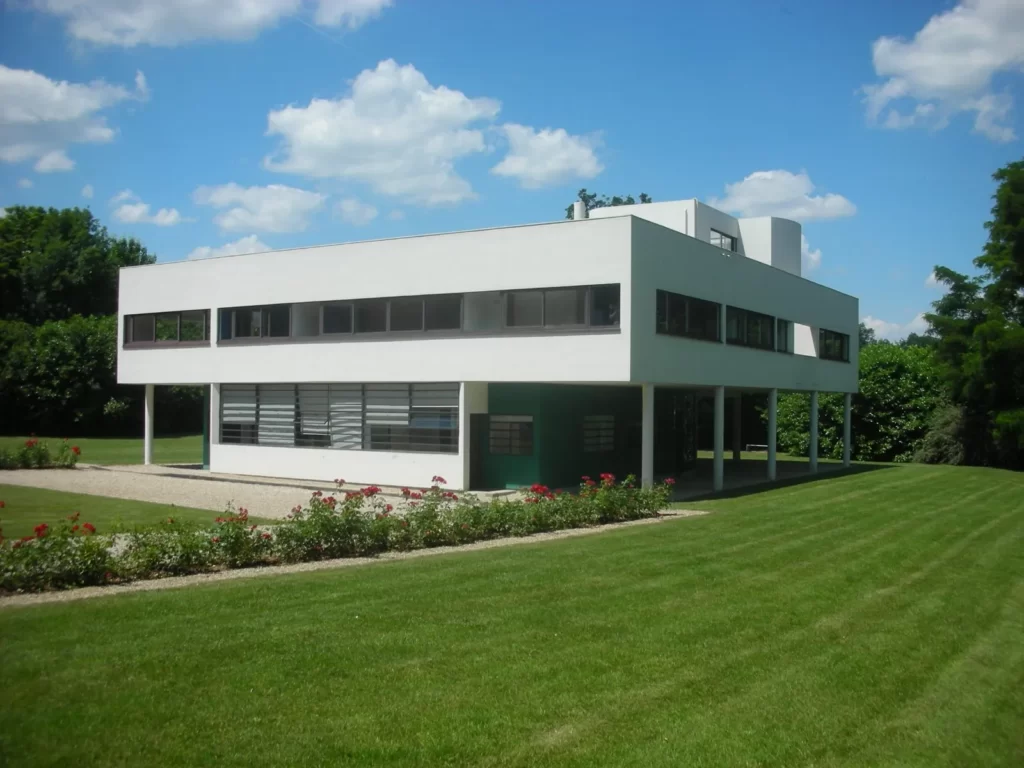

16) Design features
- Modulor design — the result of Corbu’s researches into mathematics, architecture (the golden section), and human proportion
- “Pilotis” — the house is raised on stilts to separate it from the earth, and to use the land efficiently. These also suggest a modernized classicism.
- No historical ornament
- Abstract sculptural design
- Pure color — white on the outside, a color with associations of newness, purity, simplicity, and health (Le Corbusier earlier wrote a book entitled, When the Cathedrals were White), and planes of subtle color in the interior living areas
- A very open interior plan
- Dynamic, non-traditional transitions between floors — spiral staircases and ramps
- Built-in furniture
- Ribbon windows (echoing industrial architecture, but also providing openness and light)
- Roof garden, with both plantings and architectural (sculptural) shapes
- Integral garage (the curve of the ground floor of the house is based on the turning radius)
- The Villa Savoye is a masterpiece of Le Corbusier’s purist design.
- It is perhaps the best example of Le Corbusier’s goal to create a house which would be a “machine a habiter,” a machine for living (in).
- Located in a suburb near Paris, the house is as beautiful and functional as a machine.
Today, the Villa Savoye is a popular tourist attraction and is considered a masterpiece of modernist architecture. It has been designated as a French national historic monument and was added to the UNESCO World Heritage List in 2016 as part of the “The Architectural Work of Le Corbusier, an Outstanding Contribution to the Modern Movement.”